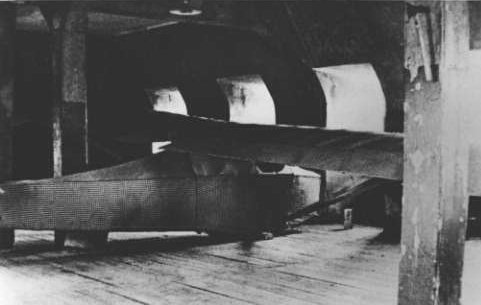
The Colditz Glider
The construction of a glider in a prison camp forms part of many escape stories. However, only in Colditz castle was this ever actually achieved. The idea of catapulting two prisoners, seated inside a glider, from the castle roof and to land on the meadow on the far side of the river Mulde was conceived by Flt Lt. Bill Goldfinch and Lt. Antony Rolt. Detailed plans of the glider had already been drawn up when Flt. Lt. Jack Best came out of solitary in the early spring of 1944. The idea was explained to him, and enthusiastically supported. Stooge Wradle, a submarine officer also joined these three, making up a team of four to construct the glider.
The team now required a secret workshop in which they could spend nearly a year constructing this glider unnoticed by the Germans. Tony Rolt had an ingenious idea. He proposed to build a false wall at one end of the attic above the chapel, sealing off a few feet in which the glider could be built.

The length of the attic would ensure that this small alteration would go unnoticed, and that the attic would pass inspection. The wall was constructed using a number of prefabricated frames, canvas palliasse covers, and debris which had been dug from the French tunnel. The next day, the attics were inspected by the Germans, and everything was found to be in order.
The plan was that on the day of the flight, a hole would be made in the west wall of the attic, and the glider moved out on to the roof. The sixteen-feet wings would be attached to the main body on a trolley, attached by a system of pulleys to a bath tub filled with concrete. Bill Goldfinch calculated that when dropped 60 feet through the floors of the castle, the bath tub would accelerate the glider beyond its stalling speed.
Construction of the glider properly began in May 1944. It continued, guarded by an elaborate stooging system, until its completion in early 1945.

The stage was set for the greatest escape of all time. Unfortunately, the allied advance across Europe had beaten them to it - Col. Tod declared that escaping from Colditz was now considered a far too great risk to take: ‘The glider is to be held in reserve in strict secrecy until the castle is liberated, or until you have further prior instructions from myself or my successor in command.’ Hence, the glider remained hidden in the attic until the castle’s liberation in April 1945. After the war, failing to appreciate the significance of the glider, the townspeople of Colditz destroyed it. In the latter months of the 20th century, as part of the Channel 4 documentary, a full scale model of the glider was constructed and flight tested. It flew perfectly.